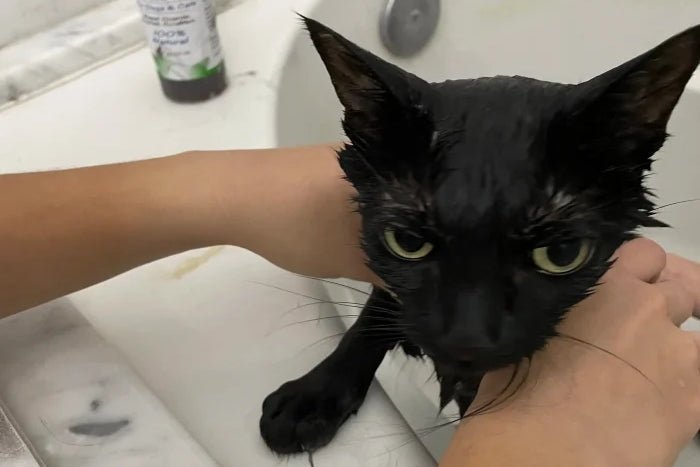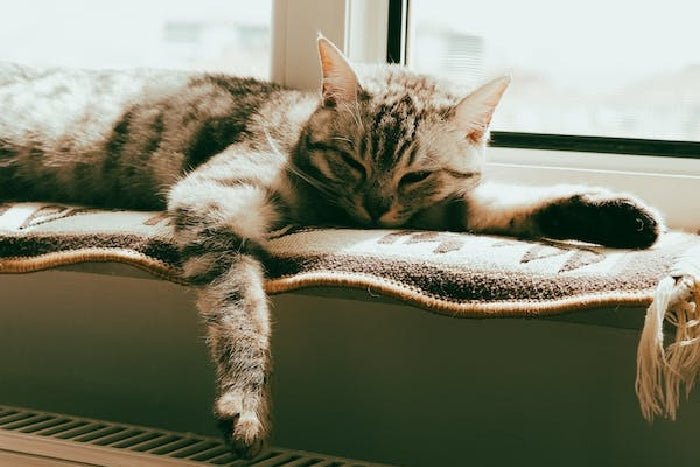Not all shampoos are safe for cats. Many contain harsh chemicals, artificial fragrances, or the wrong pH balance — all of which can damage a cat’s delicate skin. Because cats have extremely thin skin, it’s critical to use a shampoo made specifically with their needs in mind.
Why Cat Shampoo Is Different
Cats may look similar to dogs when it comes to coat care, but their biology tells another story. Cat skin is remarkably thin — only about 0.4–0.6 mm compared to a dog’s 1.0–1.5 mm. This means that cats absorb substances more easily, and their skin barrier is much more vulnerable to irritation. Human skin is thicker still, averaging around 2 mm, which is why shampoos designed for people are far too harsh for pets.
pH balance is another key difference. A cat’s skin sits at around 6.2–6.6, while dogs are closer to 6.8–7.5 and humans around 5.5. This makes human shampoos too acidic and most dog shampoos too alkaline for cats. When the pH is off, the skin barrier becomes disrupted, leading to dryness, itching, and sensitivity.
Add to this the fact that cats groom themselves constantly, meaning they ingest whatever residues are left behind, and it becomes clear: cats need shampoos designed for them.
| → Check out the ingredients in Biogreen Enriched Shampoo |
The Problem With Conventional Shampoos
Many commercial cat shampoos contain sulfates, artificial fragrances, and preservatives like parabens or formaldehyde releasers. These chemicals may make the shampoo lather well or last longer on the shelf, but they can strip natural oils, irritate thin skin, and introduce toxins that no cat should be exposed to. Artificial fragrances are especially concerning, as they are petroleum-based and can be overwhelming to a cat’s sensitive system.
Cats lack certain liver enzymes (especially glucuronyl transferase) that other animals — including humans and dogs — to break down chemicals. Many artificial fragrances are made from synthetic compounds derived from petroleum, and because cats can’t metabolize them efficiently, toxins can build up in their system instead of being safely processed.
Fragrance chemicals often contain volatile organic compounds (VOCs). These release into the air and can trigger sneezing, watery eyes, coughing, and even asthma-like symptoms in sensitive cats. Their small lungs and delicate respiratory systems make them more vulnerable than humans.

Why Phthalates Are Dangerous for Cats
Phthalates are chemicals often hidden under the word “fragrance.” They make scents last longer, but are unsafe for cats. Because cats have thin skin and groom constantly, they absorb and ingest these chemicals easily. Unlike humans, cats can’t break them down in the liver, so phthalates build up and may cause hormone disruption, organ stress, or worse.
⚠️ Did You Know?
If your pet shampoo lists “fragrance” or “parfum,” it may contain phthalates — hidden chemicals that build up in cats’ bodies and cause serious health risks.
That’s why shampoos with “long-lasting fragrance” should be avoided. PawPurity’s Biogreen Enriched Shampoo is naturally scented with organic herbs and oils and cat-safe essential oils in low amounts — no hidden toxins. This is what a clean and green shampoo should look like.

The Biogreen Enriched Difference
PawPurity’s Biogreen Enriched Shampoo was developed precisely to address these concerns. Balanced at a pH of 6.5, Biogreen is safe for cats’ delicate skin while still being effective for dogs. It cleanses gently without stripping natural oils, leaving the coat soft, shiny, and healthy.
What makes Biogreen stand out is its healing power. The formula is built on an olive and argan oils base and enriched with 20 organic herbs, plants, and oils chosen for their therapeutic properties. Together, these botanicals work to calm irritation, relieve hot spots, reduce dandruff, and support skin recovery from yeast, bacteria, and other common skin challenges.
Cat owners who use Biogreen often notice that their pets stop scratching, their skin clears up, and their coats look visibly healthier after just a few washes. It doesn’t just clean — it restores balance and comfort.
Safe, Natural Cat Skin & Coat Care
Biogreen Enriched Shampoo contains no sulfates, parabens, formaldehyde releasers, synthetic dyes, or artificial fragrances. Every essential oil is organic and carefully selected to be safe for cats’ thinner skin and frequent grooming habits. The result is a shampoo that is not only safe, but also deeply nourishing and restorative. It's highly concentrated and takes only 1 ounce or less to thoroughly wash a cat. All of PawPurity's shampoos do not suds because there are no harsh sulfates, however, they lather slightly.
⚠️ Did You Know?
Some pet shampoos contain formaldehyde releasers — preservatives banned in many countries but still used in the U.S. They slowly release formaldehyde, a chemical linked to skin irritation and cancer risk. Cats’ thin skin makes them especially vulnerable.
Cats aren’t small dogs — their thinner skin, unique pH balance, and constant grooming make them especially vulnerable to harsh ingredients. That’s why Biogreen Enriched Shampoo is more than just a cleanser. With its 6.5 pH balance, organic olive and argan oils base, and healing blend of 20 botanicals, Biogreen is designed to protect, soothe, and restore your cat’s skin and coat naturally.
Because when it comes to your cat’s health, every ingredient matters.
For more information about Biogreen Enriched Shampoo or to get expert tips on natural pet care, contact us at info@pawpurity.com or sign up for our newsletter.



